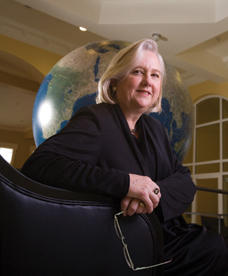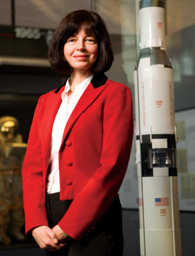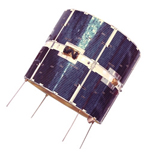Making Space Matter

Photo by NASA.gov
Getting ahold of a space lawyer can be difficult these days. Lots of lawyers travel lots, but for Joanne Gabrynowicz, director of the Air and Space Law Center at the University of Mississippi School of Law, it’s at least one way to measure growing global interest in the “rule of space.”
First, she was in South Africa, meeting with various government ministers to advance a plan for building something called the Global Earth Observation System of Systems. Then, after hosting a space law conference in Washington, D.C., she was on to China for a lecture on space law to the third nation to put people in space. “When it was only superpowers there, the law of space was a little more straightforward,” she says. “It’s always been a very international practice, but now almost every country in the world wants a seat at the table.”
Still, the community of space law remains small and collegial. At the Eilene Galloway Symposium on Space Law in December in Washington, about 100 lawyers hunched over BlackBerry devices, sharing the latest about the scrubbing of a shuttle launch that would leave a European satellite on the launch pad for another day.
“Unlike torts, contracts and other staples of the legal canon, space law is a newcomer,” says Gabrynowicz. “Its origins are still within the living memory of those engaged in it. Many of its founders are still with us making contributions.”

Joanne Gabrynowicz.
Photo by Gil Ford
Stephen E. Doyle of Shingle Springs, Calif., says it’s been that way at least since 1960, when the International Institute of Space Law first met in Paris. That organization still meets yearly and has several hundred members. Doyle, now semiretired after more than four decades in space law, estimates there are 400 to 500 space lawyers working worldwide at any time. In stints at the White House and the State Department, Doyle has helped shape some of the field’s most important policies and treaties. He chafes at the notion that space law is an obscure field, and in fact believes it’s in for some heady days in the near future.
“People are paying more attention to space and space law because it looks like there’s going to be money to be made up there,” Doyle says. “A lot of people may think it’s a free-for-all, but they’re going to find it’s not a lawless zone.”
IT’S CROWDED UP THERE
To a large extent, our world today is the product of the satellites, space stations, telescopes and other objects that we’ve put into the Earth’s orbit over the past 50 years. People across the planet are affected in ways they no longer bother to contemplate. Military campaigns and medical emergencies, telephone calls and weather forecasts, travel directions and evening newscasts all hinge on highly sophisticated hunks of metal hovering just above the Earth’s atmosphere.
“Space use has expanded tremendously,” wrote Jessica West, a program associate with Project Ploughshares in Waterloo, Ontario, Canada, in The Space Review, a weekly online publication. “These activities may not have inspired the imaginations of 40 years ago, but they are central to our way of life in the contemporary space age.”
As growing numbers of countries and private commercial operations launch various types of ventures, space—some prefer to call it “outer space”—is likely to get a lot more crowded in the coming years. More than 40 different countries now have one or more satellites in orbit. The Orbital Box Score, maintained by the U.S. Space Surveillance Network, counts 3,129 functioning “payloads” circling Earth. Of those, the U.S. has 1,081. The Commonwealth of Independent States (a confederation of 11 former Soviet republics) has 1,369. But Portugal, Algeria and Cyprus also have satellites in orbit. Mexico has seven and Saudi Arabia has 12. Japan has 102.
And while the United States, Russia and China remain the only nations to launch humans outside the Earth’s atmosphere, other countries have adopted laws governing activities in space, among them: Argentina, Australia, Finland, France, Germany, Hungary, Indonesia, Japan, New Zealand, the Philippines, Slovakia, South Africa, South Korea, Sweden, Tunisia, Ukraine and the United Kingdom.
“The current political reality of space is complex,” says Gabrynowicz. “It includes developing nations with emerging space capabilities, as well as established nations that need to demonstrate the economic and social value of space activities to their funding authorities, and that have the need to decrease costs through international cooperation and coordinating assets.”
SPUTNIK LAUNCHES, COMMERCE CHANGES
Space law traces its origins to the height of the Cold War, when the first rockets were thrust into space by the United States and the Soviet Union. At the time, lawyers debated whether a nation could put a satellite into orbit without violating the airspace of every nation it flew over.
Then in 1957, the Soviet Union shocked the world with its launch of the Sputnik satellite. The U.S. followed with orbiters of its own, triggering a space race of superpower one-upmanship, with the threat of nuclear war looming every bit as possible as placing a man on the moon.
By 1962, communications satellites were also in orbit, beaming long-distance communications around the globe, and astronauts and cosmonauts had begun circling the Earth on a regular basis. Even though the United States eventually outpaced the Soviet Union by putting men on the moon in 1969, the space race continued until the early 1990s. And the legal document that’s kept order through those years to the present is the 1967 Outer Space Treaty, negotiated at the United Nations. (Click here for the full text of of the space-related U.N. treaties.)
The Outer Space Treaty formed the legal framework of international space law. Article IV of the treaty assigns international responsibility to national space activities, whether carried out by governmental or nongovernmental entities. The first of five such international agreements, the Outer Space Treaty recognizes “the common interest of all mankind in the progress of the exploration and use of outer space for peaceful purposes.”
In addition to barring nuclear and other weapons of mass destruction from being put into orbit around the Earth, the treaty declares in Article II that “outer space, including the moon and other celestial bodies, is not subject to national appropriation by claim of sovereignty, by means of use or occupation or by any other means.”
Despite some shortcomings, the Outer Space Treaty has endured. Though there have been threats on all sides, space has not been weaponized. “The threat of nuclear weapons in space brought the world’s nations to the edge of an abyss,” says Gabrynowicz. “They peered over the edge, didn’t like what they saw and chose a different path. That kind of crisis forges principles and agreements that are unattainable in other environments.”
But in recent years, space has become accessible to more and more nations, increasingly becoming a commercial realm where private interests are at stake, not just national pride. In that environment, both the international legal schemes for space law and America’s domestic law of outer space could soon be pushed to their limits.
And no one is pushing those limits more vigorously and visibly than British billionaire Sir Richard Branson.
TICKETS TO RIDE
Branson, the flamboyant entrepreneur and adventurer, isn’t the only businessman pressing for commercial flights into space, but his Virgin Galactic space travel venture is getting lots of attention.

Photo by NASA.gov
In late January, Branson held a party at New York City’s Hayden Planetarium to unveil the designs for Virgin Galactic’s rocket, SpaceShipTwo, and White Knight Two, the airplane that will carry it high into the atmosphere before launching it into space. Some 200 people, including cosmologist Stephen Hawking, already have signed up to pay about $200,000 for the two-hour flights into low space from a launch site in New Mexico. Branson and his backers hope to start making those flights in 2010.
The U.S. government has no plans to stop such flights. Actually, Congress has directed the Office of Commercial Space Transportation in the Federal Aviation Administration to give more regulatory leeway to commercial space flights than it does to unmanned launches.
Congress created the Office of Commercial Space Transportation in 1984 pursuant to those provisions of the Outer Space Treaty that make nations responsible for space activities carried out by their private enterprises.
In 2004, Congress passed the Commercial Space Launch Amendments Act, in which it directed the FAA to treat commercial space flight ventures like adventure businesses rather than traditional commercial airlines.
“A lot of testimony at the congressional hearings on this bill made the point that people are free to pursue dangerous sports like mountain climbing despite the risks,” says Laura Montgomery, a senior attorney with the FAA. “This is an important arena of progress for mankind despite the risks.”
The permit regime instituted by the FAA will foster an era akin to barnstorming in the early days of aviation, says Montgomery. The permit process will expire in 2012, or sooner if one of the space flights crashes or the need for more stringent oversight becomes apparent.
The FAA is not mandating extensive flight safety rules, as it does for standard commercial air travel. Instead, the administration will focus much of its attention on setting mandatory liability insurance levels for launch companies and obtaining liability waivers for crew members and passengers.
Jurisdiction over vehicles once they’ve reached space is less clear, especially since so many space flights now are joint operations that may involve several countries and even private enterprises. The Outer Space Treaty states that all participants in a joint activity share responsibility for complying with its provisions, but it does not address the issue of what national laws will be used to adjudicate disputes.
Some of these issues already arise in the context of work aboard the International Space Station, and they will require more attention when commercial space travel begins. “I can’t think of any one authority for orbit,” Montgomery says. “Once we’ve got more civilians in space, Congress may have to take a look at the issue again.”
Branson and other space entrepreneurs plan to launch their space ventures whether the law is ready for them or not, says Heidi Keefe, a partner in the Palo Alto, Calif., office of White & Case who chairs the Special Committee on Space Law in the ABA Section of Science and Technology Law. “Branson’s approach has been that he’d rather beg for forgiveness later than ask for permission now, and that is what may be needed to give space law a kick,” she says.
It is precisely in this new environment that the international treaty regime and American domestic space law are beginning to show their age. The eruption of interest in satellite-based communications and entertainment systems, along with the publicity surrounding Branson’s play for space tourism, has helped fuel interest in a wide array of technologies developed by the U.S. But many space lawyers argue that regulations regarding the transfer of American technology to other nations is killing the domestic space industry. At a time when nations can’t afford to go it alone in space any longer, American lawyers say federal rules are making it harder for them to cooperate.
IRRITATION OVER ITARS
Access to U.S.-based technology is governed by the International Traffic in Arms Regulations, developed to implement provisions of the Arms Export Control Act of 1979. Known collectively as ITARs, the strict regulations require government review and approval before defense-related information and materials can be delivered outside the United States.

Laura Montgomery.
Photo by Ron Aira
Initial responsibility for reviewing such export requests was shared by the departments of Commerce and State. But concerns that Commerce had imprudently handled some sensitive exports led Congress to transfer all satellite-related ITAR requests to the State Department—treating them, in effect, as weapons technologies.
Experts say this shift not only makes it difficult for smaller nations to gain access to technologies that would bolster their space programs, but also cripples the U.S. satellite industry. So stringent are the ITAR regulations, they argue, that they are nearly impossible to meet.
“The International Traffic in Arms Regulations have either almost destroyed the U.S. satellite industry, or already have done so,” says Gabrynowicz. “The controls have become so onerous that the global satellite manufacturing and export market has migrated to other countries.”
Although other economic factors may have contributed, the Satellite Industry Association reported that in 2000—the first year after changes in the ITAR process—the global market share for U.S. companies dropped 30 percent. In addition, The Space Review has estimated that the U.S. satellite industry lost anywhere from $2.5 billion to $6 billion in revenue between 1999 and 2005, with the U.S. market share dropping by about half. European competitors have come to advertise their equipment as “ITAR-free.”
Moreover, there is a backlog. According to industry sources, more than 10,000 ITAR requests have yet to be reviewed, prompting industry leaders to send a letter of complaint to President Bush. Even research institutions say the stringent rules make it difficult to work jointly with foreign colleagues when basic information cannot be exchanged.
ITARs were the dominant topic at the recent Galloway symposium. “I think it’s telling that half of an annual space law conference was spent on ITARs,” says Harold White, executive vice president of the University of West Florida in Pensacola. “Especially since 9/11, with the increased emphasis on security, export controls have become hugely important.”
A policy analyst for another company expressed a similar view: “Everyone still prefers American products, but it’s sometimes just too hard to go through export control. It’s weakening the U.S. industrial base and strengthening the space industrial base of other countries.”
The analyst asked not to be identified because his own company has export requests currently under review.
One reason ITARs scare many lawyers is that they hold companies, universities and research institutions strictly liable for any inadvertent transfers of technology. In 1998, Boeing was fined $10 million for violations of the Arms Export Control Act.
“When I tell clients about the strict liability, after they pick their chins up off the floor, I tell them that there are ways to mitigate the risk,” says Franceska O. Schroeder, a principal at Fish & Richardson in Washington, D.C.
Government lawyers insist that the review periods for satellite-related ITARs are getting shorter, and they note that most technology transfers are ultimately approved. And some industry lawyers say it’s time to learn to live with ITARs.
“I think the hysteria over ITARs is out of proportion,” says Pamela L. Meredith, who co-chairs the space law practice group at Zuckert, Scoutt & Rasenberger in Washington, D.C. “They’ve been around for a long time now, so people have had time to adjust.”
A CHINESE KNOCKDOWN
The new interest in extraterrestrial commerce, however, has not wholly displaced anxieties about military applications in space.
In January 2007, the Chinese used a projectile from a ballistic missile to destroy one of its own aging weather satellites. The blast left a trail of flotsam that, according to NASA, now accounts for 42 percent of all satellite breakup debris, a large component of the orbiting man-made detritus known as “space junk.”
In the void of space, even tiny particles of debris can wreak havoc if they collide with other satellites, but that is not the only concern. Although the U.S. had conducted a similar test in 1985, the aggressive Chinese display left many rattled by the military implications of their ability to destroy satellites.
One of the enduring principles of the Outer Space Treaty is the commitment to keeping space free of nuclear weapons and other weapons of mass destruction. But just because it hasn’t been weaponized doesn’t mean it hasn’t been militarized. Surveillance and tracking technology—much of it provided by commercial satellites—has become vital to U.S. military operations, so China’s satellite destruction was, for some, a cause for alarm.
Still, China and Russia have supported a U.N. resolution calling for a new treaty against space weaponization; but the U.S. has remained noncommital, even wary.
In 2006, President Bush signed a national space policy directive that keeps U.S. options open. “The United States will oppose the development of new legal regimes or other restrictions that seek to prohibit or limit U.S. access to or use of space,” the directive states.
Some experts say there’s nothing new in the U.S. government’s latest expression of space policy.
“It’s a big hullabaloo over nothing,” says space law veteran Doyle, who helped negotiate the Outer Space Treaty. “Wow, the United States has an assertive space policy? If anyone would look at the policy directives going back to the 1950s, they’d see nothing has changed. We’ve had the same policy for a long time.”
Moreover, a preoccupation with the militarization of space “misses the point,” says Keefe. “It keeps people from focusing on the possibility of using space in a positive way.”

Photo by ESA
IS THE COMMON INTEREST ENOUGH?
Ultimately, say Keefe and others, the most important contribution of commercial space flights may be to raise awareness about the potential for other commercial uses of space—everything from resorts on the moon and new products developed in the unique environment of space labs to mining resources on Mars and even asteroids.
At the same time, they caution, the commercialization of space is likely to pose the greatest test for the continuing viability of the international legal regime that has governed human activity in space for the 40 years the Outer Space Treaty has been in force.
“I’m astonished that the treaty system still works,” Keefe says. “I think it’s a testament to the spirit of the original drafters that it still functions, but eventually I think we’ll have to adjust our approach to space.”
In viewing space as the province of mankind, the Outer Space Treaty borrows principles from customary maritime law, which guarantees peaceful passage through navigable waters by ships of all nations. But in application, the Outer Space Treaty is more similar to the Antarctic Treaty System, a series of international agreements that call for cooperative management of Antarctica as a nonmilitarized environment and put off claims of sovereignty for an indefinite period.
But as the prospects for commercial ventures in space increase, it will be necessary to address the issue of who will be allowed to profit from the fruits of those ventures, say lawyers in the field.
“The current system works if nations accept a détente in space and all the resources are only used for the benefit of all mankind,” Keefe says. “If that’s the case, then there will never be commercialization of space and there will be little benefit for mankind. I know that’s a cynical capitalist viewpoint, but I think if everyone is afraid to launch a venture because they might not be allowed to profit from it, then nothing will happen.”
The dawning awareness of the potential conflict between “the common interest of all mankind” on the one hand, and national interests and potential profits on the other, is reflected in the lukewarm reception by national governments to the Moon Agreement, the last of the five U.N. treaties that provide the basis for international law relating to space.
The Moon Agreement (more formally, the Agreement Governing the Activities of States on the Moon and Other Celestial Bodies) essentially restates the commitment of the Outer Space Treaty to treat the moon for the common interest of all mankind. Though adopted by the U.N. General Assembly in 1979 and placed in force in 1984, only 13 nations have ratified it.
Many countries, especially the space powers, were concerned they might not be able to engage in mining or other commercial activities, so the Moon Agreement languished. Many in the field now believe those same concerns may require the Outer Space Treaty to be revisited and revised.
“We need to encourage people to explore space,” says Keefe, “and the only way to encourage more investment in space is to have a clearer understanding of what the law says about those investments. We need to see if there’s a way to reward those who make investments while protecting the interests of humanity.”
Others are more cautious about disrupting a legal regime that has worked effectively for the past four decades. “You can’t say space is lawless because there’s no prescriptive law about everything, but there is a regime in place for keeping it regulated,” Doyle says. “There’s no sense in making laws in anticipation of developments.”
The timing of the debate over what to do about commercial enterprises in space could be crucial. “It’s a chicken-and-egg thing,” says Keefe. Some want to see the Outer Space Treaty amended now, while others prefer to wait until commercial activities in space actually begin.
“One of the problems right now,” she says, “is that everyone’s waiting for each other to blink.”
Web extras:
The Air and Space Law Center at the University of Mississippi School of Law
Res Communis, the Air and Space Law Center’s blog
United Nations Treaties and Principles on Space Law



